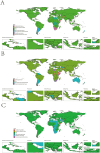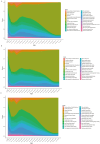Global, regional, and national burdens of traumatic brain injury from 1990 to 2021
- PMID: 40297033
- PMCID: PMC12034675
- DOI: 10.3389/fpubh.2025.1556147
Global, regional, and national burdens of traumatic brain injury from 1990 to 2021
Abstract
Background: Of all the injuries on a global scale, traumatic brain injury (TBI) has the most serious consequences for the individual. Depending on its severity, it can be classified as minor, moderate, or severe, but even minor TBI can sometimes still cause severe functional deficits. This study seeks to assess the latest burden of TBI and analyze their differences in terms of country, age, sex, and cause.
Methods: Based on the Global Burden of Diseases database, the incidence, years lived with disability (YLDs), and causes of total head injuries, minor TBI, and moderate/severe TBI from 1990 to 2021 were analyzed separately by sex, age group, and region.
Results: In 2021, there were 20,837,465 [95% uncertainty interval (UI): 18,128,306-23,839,393] new cases of TBI worldwide, with an age-standardized incidence of 259 cases per 100,000 population (95% UI: 226-296). From 1990 to 2021, there was a decline in global age-standardized incidence (estimated annual percentage change: -0.11, 95% UI: -0.18% to -0.04%). In 2021, countries with higher rates will be mainly in Central and Eastern Europe and the Middle East. In 2021, the global incidence of TBI in all age groups was higher in men than in women. Falls are the leading cause for most age groups in most areas.
Discussion: TBI still accounts for a significant portion of the global injury burden in 2021, but differences do exist between countries. This study introduced the possibility of TBI with different degrees and the trend of injury causes in different age groups and regions from 1990 to 2021, providing a basis for further research on injury causes in different regions and formulating corresponding policies and protection measures in the future.
Keywords: burden of disease; epidemiology; global health; public health; traumatic brain injury.
Copyright © 2025 Yan, Wang and Sun.
Conflict of interest statement
The authors declare that the research was conducted in the absence of any commercial or financial relationships that could be construed as a potential conflict of interest.
Figures





References
-
- Asehnoune K, Lasocki S, Seguin P, Geeraerts T, Perrigault PF, Dahyot-Fizelier C, et al. . Association between continuous hyperosmolar therapy and survival in patients with traumatic brain injury - a multicentre prospective cohort study and systematic review. Crit Care. (2017) 21:328. doi: 10.1186/s13054-017-1918-4, PMID: - DOI - PMC - PubMed
-
- Sloan SWD, Anson K. Long-term outcome following traumatic brain injury. Brain Impairment. (2007) 8:251–61. doi: 10.1007/978-3-030-78075-3_34 - DOI
MeSH terms
LinkOut - more resources
Full Text Sources
Medical

